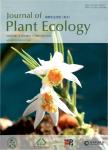Size-asymmetric root competition in deep,nutrient-poor soil
作者机构:Department of Plant and Environmental SciencesUniversity of CopenhagenHøjbakkegaard Allé13Taastrup DK-2630Denmark Department of Plant and Environmental SciencesUniversity of CopenhagenThorvaldsensvej 40Frederiksberg DK-1871Denmark
出 版 物:《Journal of Plant Ecology》 (植物生态学报(英文版))
年 卷 期:2019年第12卷第1期
页 面:78-88页
核心收录:
学科分类:09[农学] 0903[农学-农业资源与环境] 090301[农学-土壤学]
基 金:supported by a Ph.D. stipend from the University of Copenhagen to Anne Nygaard Weisbach by the University of Copenhagen Program of Excellence
主 题:below-ground competition resource pre-emption size inequality size advantage Triticum aestivum
摘 要:Aims There is much evidence that plant competition below ground is size symmetric,*** competing plants share contested resources in proportion to their *** researchers have hypothesized that a patchy distribution of soil nutrients could result in size-asymmetric root *** tested this *** In a greenhouse experiment,Triticum aestivum(wheat)individ-uals of different initial sizes were grown alone or with below-ground competition from one neighbour,in 1 m tall,narrow containers in a nitrogen-poor field soil with(i)no added nitro-gen,(ii)nitrogen fertilizer mixed into the upper 50 cm,and(iii)the same amount of fertilizer mixed into a 20-30 cm deep *** measured total leaf length throughout the experiment,and above-ground biomass and nitrogen concentration at *** also measured root depth and frequency over time in a subset of *** Findings Competing plants were half the size of non-competing plants,meaning that root competition was very *** competition was size-asym-metric to some degree in all soil *** larger than the target plant showed a greater per-unit-size effect on target growth than neighbours smaller than the *** variation increased over time for competing individuals,but decreased for non-competing *** to expectations,the presence of a high-nutrient patch reduced the strength and size asymmetry of competition *** asym-metry in poor,deep soils may result from directionality in resource interception as roots compete for limited nutrients by growing deeper into soil layers that have not yet been *** competition can be size asymmetric,but not to the same degree as competition for light.



